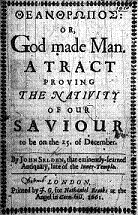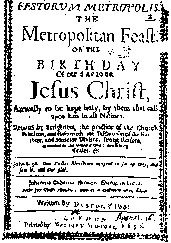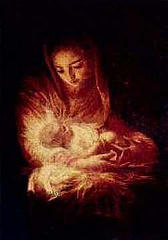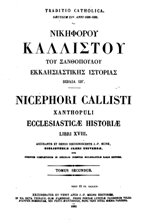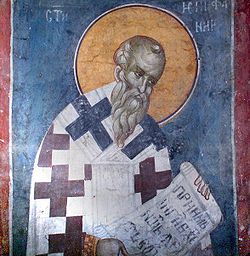The Virgin Birth and Divine Heir of
the Davidic Throne
Time & Eternity met in Bethlehem Dec. 25th
In this article we survey prophetic
references to the incarnation of Christ from Mary’s womb until
the cross, and the garden until his birth in Bethlehem.
The sacred seed-line from Adam to David
Our first ancestors were made in the image
and likeness of God and stood in no need of a Savior, but were
in a state of perfect innocence before God. However, with the
fall the race became “carnal, sold under sin” (Rom. 7:14). That
is, whereas God made man good and upright, the fall morally
estranged man from his Maker. Those who are opposed to God,
obeying the flesh rather than the Spirit, cannot live forever.
Man’s moral estrangement from God therefore brought him into
bondage to sin and death. Willing that men should be redeemed
and not eternally lost, God promised a “kinsman redeemer” who
would vanquish sin and death, and enable men to share in eternal
life.
And
the Lord God said unto the serpent, because thou hast done this,
thou art cursed above all cattle, and above every beast of the
field; upon thy belly shalt thou go, and dust shalt thou eat all
the days of thy life: And I will put enmity between thee and the
woman, and between thy seed and her seed: it shall bruise thy
head, and thou shat bruise his heel. Gen. 3:14, 15
The serpent is a symbol for the power of
sin and death; its seed is a symbol for the children of
disobedience who live in alienation and enmity toward God. The
woman is a symbol for the bride, the covenant people of God. The
woman’s seed is Christ. The sting (venom) of death is sin, and
the strength of sin is God’s moral law (I Cor. 15:56), for
without law there is no transgression (Rom. 4:15). The serpent’s
seed would bruise Christ’s heel in the cross; but Christ would
crush the serpent’s head in his substitutionary death and
atoning sacrifice, providing forgiveness of our transgressions.
Note, however, that in procreation, the man provides the seed,
the woman the egg (Gen. 38:9; Lev. 15:16). That seed is here
attributed to the woman therefore almost certainly alludes to
the virgin birth of Christ.[1]
The sacred seed-line by which God would
bring the Savior into the world would be a people of faith; a
people whose moral disposition was to receive and to obey the
word of God. From Adam, the seed-line descended to Abel. Abel
was slain by Cain and thus replaced by Seth. From Seth it
descended to Noah and his son Shem. From Shem, it descended to
Abraham, Isaac, and Jacob, and thence to the tribe of Judah.
Judah would be the royal tribe holding the monarchial scepter
whence Christ would descend, here called Shiloh:
The
scepter shall not depart from Judah, nor a lawgiver from between
his feet, until Shiloh come; and unto him shall the gathering of
the people be. Gen. 49:10
The monarchy over Israel was first held by
the tribe of Benjamin and the house of Saul, son of Kish (I Sam.
9, 10). However, Saul was rejected for rebelling against the
word of God, and David, the son of Jesse, of the tribe of Judah
and the town of Bethlehem, was anointed to become king in his
place (I Sam. 15:23; 16:1, 13). God called David a “man after
his own heart” (I Sam. 13:14), and promised that his throne and
dynasty would endure forever, and that Christ would be born of
his seed:
And
when thy days be fulfilled, and thou shalt sleep with thy
fathers, I will set up thy seed after thee, which shall proceed
out of thy bowels, and I will establish his kingdom. He shall
build an house for my name, and I will stablish the throne of
his kingdom forever. I will be his father, and he shall be my
son. I Sam. 7:12-14
In its immediate historical context, this
promise applied to Solomon who built the Jerusalem temple.
However, the plenior sensus (fuller sense) of the passage is clearly messianic
and points to Christ. The greatness of Solomon’s kingdom, which
was the world-power of its day, would serve as a prophetic type
pointing to the kingdom and reign of the Messiah who rules over
earth’s people from the right hand of God in heaven and whose
church is a spiritual temple. The sacred-seed line therefore
descended from Abraham to Judah and thence to the house of
David, to which would be born Christ. It is in David, therefore,
that messianic prophecies assume a royal dimension.
The Prophecy of the Virgin Birth
Isaiah 7:13-16 –
And he said, Hear ye now,
O house of David; Is it a small thing for you to weary men, but
will ye weary my God also? Therefore the Lord himself shall give
you a sign; Behold, a virgin shall conceive, and bear a son, and
shall call his name Immanuel. Butter and honey shall he eat,
that he may know to refuse the evil, and choose the good. For
before the child shall know to refuse the evil, and choose the
good, the land that thou abhorrest shall be forsaken of both her
kings.
The historical context of the prophecy of
the virgin birth requires explanation.
Following the reign of Solomon, Israel
became a divided kingdom. The ten northern tribes broke away
from the house of David and became a separate kingdom (I Kng.
12). The dynasties of the northern kingdom were generally
short-lived and suffered numerous changes. However, the house of
David continued to rule over the tribes of Judah and Benjamin in
Jerusalem. Unfortunately, few of the kings of Judah were like
David; the majority failed to prepare their hearts to seek the
Lord and consequently wandered into idolatry and sin. Ahaz, to
whom the above prophecy was addressed, was among the evil kings
(II Kng. 16; II Chrn. 28). Hence, the tone of the prophecy,
saying, “will ye weary God also?” The sins of Ahaz and Judah caused God to
deliver the land into the hands of Rezin, the king of Syria, and
Pekah, the king of Israel, who smote the land and carried away
many captives (II Chrn. 28:1-5). These two kings also sought to
overthrow the house of David and place the son of Tabeal upon
the throne (Isa. 7:6; cf.
II Chrn. 28:6-15). However, God’s purpose to bring Christ into
the world through the Davidic line meant that their attempted
overthrow of the house of David would not succeed: God would
preserve Judah and the house of David. Within sixty-five years
God would cause the northern tribes to be carried into captivity
in Assyria (Isa. 7:7-9). In assurance that God would preserve
Judah and the house of David, God told Ahaz to ask from heaven a
sign (v. 11). However, Ahaz feigned reverence for God and said
he would not tempt the LORD by asking a sign (v. 12). God
answered, saying, he himself would give a sign: a child would be
born whom, while still tender and young, would see the overthrow
of the kings of Syria and the northern kingdom. This was
fulfilled in twelfth year of Ahaz when Hoshea conspired against
Pekah and slew him and reigned in his place (II Kng. 15:30;
17:1).[2]
Nine years later, the king of Assyria carried the northern
kingdom into captivity (II Kng. 17:6-23).
The messianic dimension of the prophecy of
the virgin birth and its fulfillment in Jesus are well known
(Matt. 1:23). However, since Ahaz would not be alive when Jesus
was born, the sign of Immanuel given in token that God would
preserve Judah and the house of David necessarily had a
historical dimension fulfilled in Ahaz’ day. In its immediate
historical context, the child named “Immanuel” was almost
certainly Isaiah’s son. This is clear from Isa. 8:1-4 where
Isaiah takes to wife a prophetess who conceives and bears the
prophet a son. Isaiah is divinely instructed to name the child
“Mahershalalhashbaz,” which is translated “swift to the spoil,
swift to the prey,” and was prophetic of the ruin that would
shortly befall Samaria and Damascus. The child
“Mahershalalhashbaz” is also probably “Immanuel” (see Isa. 8:8).
Isaiah, whose other son was named “Sherarjashub” (“a remnant
shall return”), next states
“Behold, I and the
children whom the LORD hath given me are for signs and for
wonders in Israel from the LORD of hosts, which dwelleth in
Zion” (Isa. 8:18). In other words, Isaiah’s children were
divinely named and served as tokens of God’s favor upon Judah
and the house of David. In light of these considerations, it
seems probable that the “virgin” originally referred to the
prophetess Isaiah married who conceived a child through normal
conjugal relations (cf.
v.3). The Hebrew word “almah” (Isa. 7:14), used of the
prophetess, can mean either “young woman” or “virgin” so that
its use seems to deliberately anticipate the dual aspect of the
prophecy as it related to Isaiah’s wife and ultimately the
virgin Mary.
The sign to king Ahaz implicit in
Immanuel’s birth may have stemmed in part from Isaiah himself.
Isaiah’s ministry spanned the reigns of Uzziah, Jotham, Ahaz and
Hezikiah (Isa. 1:1). Uzziah reigned fifty-two years; his son
Jotham reigned sixteen years; Ahaz, in whose days the prophecy
of the virgin birth was given, likewise reigned sixteen-years
(II Chrn. 26:3; 27:1; 28:1). Therefore, it may be that by the
time of the instant prophecy Isaiah was of advanced age such
that the prophetess conceiving a son by him bespoke divine
intervention which thus became a sign of God’s wonderous
deliverance of Judah and the house of David. However, that Jesus
was born to a virgin is beyond dispute. Matthew uses the Greek
term parthenos to
describe Mary in quoting Isa. 7:14 (Matt. 1:23). Moreover, the
Septuagint, a Greek translation of the Hebrew scriptures dating
to the third century BC, also uses this term in translating the
Hebrew almah, so that
it is clear the Jews themselves understood the word in precisely
the same terms as Matthew.[3]
The Incarnation Psalm – Christ in Mary’s Womb?
David, who was also a prophet, so ordered
his life and kingdom that he became a figure for the Messiah.
Ezekiel thus prophesied of Christ in the name and person of
David, as if the Messiah would be the re-embodiment of David
himself:
And I
will set up one shepherd over them, and he shall feed them, even
my servant David; he shall feed them, and he shall be their
shepherd. And I the LORD will be their God, and my servant David
a prince among them; I the LORD have spoken it. Ezk.34:23, 24
And
David my servant shall be king over them; and they all shall
have one shepherd: they shall also walk in my judgments, and
observe my statutes, and do them…and my servant David shall be
their prince forever. Ezk. 37:24, 25
Hosea is to the same effect:
Afterward shall the children of Israel return, and seek the LORD
their God, and David their king; and shall fear the LORD and his
goodness in the latter days. Hosea 3:5
The fact that David became a figure for
Christ is important in understanding many of the Psalms.
Although David composed many Psalms in response to his personal
experiences, the plenior
sensus was often messianic and both prefigured and spoke in
the person of Christ. This is clear from Peter’s sermon on the
first Pentecost after Christ rose from the dead where Peter
assures his listeners that, although David wrote the sixteenth
Psalm, it was prophetic and spoke in the person Christ (Acts
2:25-31):
I
have set the LORD always before me: because he is at my right
hand, I shall not be moved. Therefore, my heart is glad and my
glory rejoiceth: my flesh also shall rest in hope. For thou wilt
not leave my soul in hell [Sheol/Hades]; neither wilt thou
suffer thine Holy One to see corruption. Thou wilt shew me the
path of life: in thy presence is fulness of joy; at thy right
there are pleasures for evermore. Ps. 16:8-11
Other Psalms in which David speaks in the
person of Christ include Psalm 22:16-18:
They
pierced my hands and my feet. I may tell all my bones: they look
and stare upon me. They part my garments among them, and cast
lots upon vesture (cf. Matt. 27:35).
Psalm 41:9:
Yea,
mine own familiar friend, in whom I trusted, which did eat of my
bread, hath lifted up his heel against me (cf. John 13:18).
Indeed, the whole of Psalm 119, which is
176 verses long, although nominally written by David, appears in
reality to be the person of Christ. The repeated reference to
his enemies and petitions that God “quicken me” (Ps. 119:25,
149, 156, 159, 175) seem to have reference to Christ’s
afflictions and his resurrection from the dead:
My
zeal hath consumed me, because mine enemies have forgotten thy
words…Consider how I love thy precepts: quicken me, O LORD,
according to thy lovingkindness. Ps. 119:139, 159
Since many of the Psalms are impressed with
a prophetic dimension which speaks in the person of Christ, it
is possible, if not probable, that the 139th Psalm
foretells the incarnation:
For
thou hast possessed my reins: thou hast covered me in my
mother’s womb. I will praise thee; for I am fearfully and
wonderfully made: marvelous are thy works; and that my soul
knoweth right well. My substance was not hid from thee, when I
was made in the secret, and curiously wrought in the lowest
parts of the earth. Thine eyes did see my substance, yet being
unperfect; and in thy book all my members were written, which in
continuance were fashioned, when as yet there was none of them.
Ps. 139:13-16
This should be compared with the prophecies
of Isaiah, which specifically refer to Jesus in Mary’s womb:
Listen, O isles, unto me; and hearken, ye people, from far; The
LORD hath called me from the womb, from the bowels of my mother
hath he made mention of my name. And he hath made my mouth like
a sharp sword; in the shadow of his hand hath he hid me, and
made me a polished shaft; in his quiver hath he hid me…And now,
saith the LORD that formed me from the womb…Is it a light thing
that thou shouldest be my servant to raise up the tribes of
Jacob, and to restore the preserved of Israel: I will also give
thee for light to the Gentiles, that thou mayest be my salvation
unto the end of the earth. Isa. 49:1, 2, 5, 6
Here we read of Christ being formed in his
mother’s womb, equipped with a tongue like a sharp sword,
himself a polished arrow to bring salvation to the ends of the
earth. Read together, it is difficult not to see Christ in the
139th Psalm, which bespeaks God’s care and provision
for Jesus while he was in a state of total human helplessness as
a still unformed babe. To these must next be added Psalm 40:6, 7
where the Psalmist speaks in the person of Christ saying God had
“prepared a body” for him in sacrifice for sin (LXX;
cf. Heb. 10:5-10):
Sacrifice and offering thou didst not desire; a body hast thou
prepared for me: burnt offering and sin offering hast thou not
required. Then said I, Lo, I come: in the volume of the book it
is written of me.
The “body prepared” for Jesus mentioned in
Psalm 40 was destined to be nailed to a cross in sacrifice for
sin. However, Jesus did not lose faith and trust in God even in
death, knowing that from the very womb God’s superintending
providence had been with him and would redeem him from death and
the grave. Hence, David prophetically causes Jesus while upon
the cross to look back upon God’s care for him, even from the
womb:
All
they that see me laugh me to scorn: they shoot out the lip, they
shake the head, saying, He trusted on the LORD that he would
deliver him let him deliver him, seeing he delighted in him. But
thou art he that took me out of the womb: thou didst make me
hope when I was upon my mother’s breasts. I was cast upon thee
from the womb: thou art my God from my mother’s belly. Ps.
22:7-10
These many references to Jesus and the womb
of his mother argue that Psalm 139 provides a glimpse of the
incarnation while as yet Christ was unformed in the womb of the
virgin Mary. At the very least, Jesus’ common humanity means
that, even if the 139th Psalm is not directly about
Christ, it nevertheless expresses sentiments fully applicable to
him, giving us pause to stop and wonder at the work of God in
bringing the Savior into the world.
The Visible Form of Christ
Isaiah said God formed Jesus in his
mother’s womb (Isa. 41:5). It may therefore be appropriate to
pause momentarily and consider the visible appearance that form
took.
Man is a worshiper of images; he adores
that which is pleasing to the eye, particularly physical beauty.
It is therefore not surprising that artists consistently portray
Christ as physically beautiful and attractive. This is equally
true of Mary who is consistently portrayed in forms that are
physically pleasing. That Christ or Mary should have been of
merely average appearance, or even unattractive or (Lord forbid)
ugly, seems to us inconceivable. Doubtless, sin has defaced and
marred the race, and it is difficult to think of the spotless
Lamb of God as suffering from this aspect of the fall. However,
although Jesus had no human father and was therefore free from
the moral corruption and estrangement inherent in Adam’s race,
Jesus nevertheless took on him the form of our fallenness and
was made “in the likeness of sinful flesh” (Rom. 8:3). That is
to say, Jesus was just like you or I and suffered all the same
complaints of our physicality, including those associated with
our appearance.
Two groups of scriptures exist describing
how Jesus looked. The first group describes Jesus as he appeared
because of what he endured to ransom us from sin; they detail
for us the gross disfigurement he suffered from scourging and
crucifixion:
I am
poured out like water, and all my bones are out of joint: my
heart is like wax; it is melted in the midst of my bowels. My
strength is dried up like a potsherd: and my tongue cleaveth to
my jaws; and thou hast brought me into the dust of death. For
dogs have compassed me: the assembly of the wicked have inclosed
me: they pierced my hands and my feet. I may tell all my bones:
they look and stare upon me.” Ps. 22:14-17
Thirst and dryness caused his tongue to
cling to his jaws; gravity pulled at his body until strength to
resist was gone. Hanging upon the cross, the joints of Jesus’
arms and shoulders suffered dislocation and his bones protruded
from beneath his flesh; dogs licked his blood;[4]
men stood and stared. Indeed, Isaiah says that scourging and
crucifixion marred Jesus’ physical appearance to the point of
wonder and astonishment, stopping even the mouths of kings:
As
many were astonied at thee; his visage was so marred more than
any man, and his form more than the sons of men. So shall he
sprinkle many nations; the kings shall shut their mouths at him:
for that which had not been told them shall they see; and that
which they had not heard shall they consider…But he was wounded
for our transgressions, he was bruised for our iniquities: the
chastisement of our peace was upon him; and with his stripes we
are healed. Isa. 52:14, 15; 53:5
The second group of scriptures describe
Jesus as being of average to less-than-average appearance and
attractiveness:
Who
hath believed our report and to whom is the arm of the LORD
revealed? For he shall grow up before him as a tender plant, and
as a root out of a dry ground: he hath no form or comeliness;
and when we shall see him, there is no beauty that we should
desire him. Isa. 53:1, 2
Here we learn that Jesus had “no beauty”
and no “comeliness;” there was nothing in his appearance that
“we should desire him.” The perfect Lamb of God was, in would
seem, unattractive to his fellow man! Certainly, the God who
formed Christ in his mother’s womb, who “did
see my substance, yet being unperfect,” could have made
Jesus tall like king Saul, who was head and shoulders taller
than all others (I Sam. 10:23); or might have made Jesus
handsome like Absolom, David’s son, of whom it is written that
“there was none to be so much praised for his beauty” (II Sam.
14:25). Yet, God in his wisdom chose otherwise. Indeed, it may
be that Jesus’ unassuming appearance served to punctuate his
harmlessness and innocence. Absolom’s beauty no doubt played a
role in his gaining a dangerous following that cast the nation
into civil war. Similarly, Saul’s physical stature doubtless
helped persuade men to follow him into battle and helped
establish him as king over Israel. In this light, the decision
that Jesus be plain and unattractive in outward appearance makes
perfect sense: Jesus was not destined to an earthly throne or
kingdom and therefore had no need of the things usually helpful
to those seeking earthly power. Had he possessed physical beauty
it would likely have exposed him to greater suspicion and danger
from the rulers who were already jealous of him and laid in wait
catching at his words. It may also have hindered the spiritual
nature of Christ’s mission, distracting men with his outward
form rather than directing them to his words and the Spirit of
God that dwelt within.
A final point that bears notice before
moving on is that not only was Jesus physically plain and
unattractive, it appears that he had a weak constitution and
suffered recurring illness. Isaiah’s testimony in this regard is
clear:
Surely he hath borne our griefs, and carried our sorrows: yet we
did esteem him stricken, smitten of God, and afflicted. Isa.
53:4
Jerome’s Latin translation makes the point
better:
Truly, he has borne our
infirmities [Lat.,
languores], and carried our sorrows; and we thought him
diseased [Lat., leprosum], stricken of God and afflicted.
Matthew affirms that this is Isaiah’s
meaning when he renders the passage
“Himself took our
infirmities, and bare our sicknesses” (Matt. 8:17).
It is probably fair to say that terms like
“smitten and afflicted” would normally be reserved for something
more than an occasional cold or flu, but rather describe persons
suffering frequent and recurring illness. This suggests that
Jesus was like Timothy, whose weak constitution caused Paul to
recommend the use of wine for his “often infirmities” (I Tim.
5:23). If so, Isaiah’s testimony sheds light upon a little
discussed but interesting and important aspect of the
incarnation.
Christ – Divine Heir of the Davidic Throne
If the 139th Psalm develops the
theme of Jesus’ humanity, several other Psalms and passages
develop the theme of Christ’s divinity, typically in the context
as heir of David’s throne. The prophet Isaiah combines these
themes in language that has found a permanent place in the
pageantry of Christmas via Handel’s
Messiah:
For
unto us a child is born, unto us a son is given: and the
government shall be upon his shoulder: and his name shall be
called Wonderful, Counselor, the mighty God, the everlasting
Father, the Prince of Peace. Of the increase of his government
and peace there shall be no end, upon the throne of David, and
upon his kingdom, to order it, and to establish it with judgment
and with justice from henceforth even forever. The Zeal of the
LORD of hosts will perform this. Isa. 9:6, 7
The sign of “Immanuel,” which is translated
“God with us” (Isa. 8:8, 10; Matt. 1:23), finds confirmation
here in the divinity attributed to the messianic Prince.
Although a son in his humanity, Christ is the mighty God and
everlasting Father in his divinity. David also affirmed Christ’s
divinity in Psalm 110:1:
The
Lord said unto my Lord, Sit thou at my right hand, until I make
thine enemies thy footstool.
Jesus quoted this Psalm in a discussion
with Pharisees, asking,
What
think ye of Christ, whose son is he? They say unto him, The son
of David. He saith unto them, How then doth David in Spirit call
him Lord, saying, The Lord said unto my Lord, Sit thou on my
right hand, till I make thine enemies thy footstool? If David
then call him Lord, how is he his son? Matt. 22:41-46
Jesus was the son of David in his humanity
(Luke 1:32). However, in his divinity he was LORD. He went to
the cross as a man, but he reigns upon the throne of David as
God. So, the prophet Daniel:
I saw
in the night visions, and, behold, on like the Son of man came
with the clouds of heaven, and came to the Ancient of days, and
they brought him near before him. And there was given him
dominion, and glory, and a kingdom, that all people, nations,
and languages, should serve him: his dominion is an everlasting
dominion, which shall not pass away, and his kingdom that which
shall not be destroyed. Dan. 7:13, 14
It is probably to this vision of Daniel
that Stephen referred just prior to being stoned, when he said,
“Behold, I see the heavens opened, and the Son of man standing on the
right hand of God” (Acts 7:56). Indeed, virtually all New
Testament writers, beginning with Peter in Acts to John in
Revelation, affirm that Psalm 110:1 was fulfilled at Christ’s
ascension so that that there can be no question that Jesus has
resumed his divinity and reigns over the world, providentially
guiding history for the advancement of his gospel and kingdom
and the salvation of mankind (Acts 2:33-35; Eph. 1:20; Heb. 1:3;
10:12; Rev. 2:27; 3:21).
And
without controversy great is the mystery of godliness: God was
manifest in the flesh, justified in the Spirit, seen of angels,
preached unto the Gentiles, believed on in the world, received
up into glory. I Tim. 3:16
Time and Eternity meet in Bethlehem Dec. 25th
If humanity and divinity were united in
Christ, time and eternity met in Bethlehem with the Savior’s
birth:
But
thou, Bethlehem Ephratah, though thou be little among the
thousands of Judah, yet out of thee shall he come forth unto me
that is to be ruler in Israel; whose goings forth have been from
of old, from everlasting. Micah 5:2
Bethlehem means “house of bread,”
perhaps in veiled prophecy of the nativity of him who is the
“bread of life” (Jn. 6:48). It was anciently known as Ephrath
(Gen. 35:16; 48:7; Ps. 132:6), and was the place where Rachel
died and was buried (Gen. 35:19; 48:7); it was also where the
story of Ruth took place, and was the home and the city of David
(I Sam. 16:1, 4; Jn. 7:42). However, Bethlehem was not the home
of Joseph or Mary. Luke informs us that the couple made their
home instead in Nazareth of Galilee (Lk. 1:26; 2:39). According
to Luke, it was in obedience to the decree of Caesar Augustus
“that all the world be taxed” (or registered) that Joseph
travelled to Bethlehem with Mary his espoused wife “being great
with child” (Lk. 2:1-7). This registration was probably that
associated with Augustus receiving the title of
Pater Patriae in
February of 2 B.C.[5] This would
be consistent with Luke’s statement that Jesus was on the
threshold of his thirtieth birthday when baptized in the fall
A.D. 29, for someone born in 2 B.C. will turn 30 years old by
December 31st A.D. 29 (Luke 2:1, 23), placing both
the registration of Augustus and nativity of Christ in 2 B.C.
Bethlehem’s final mention is in
connection with the Slaughter of the Innocents. Forty days after
Jesus’ birth, the holy family travelled to Jerusalem where
customary sacrifices were made for firstborn sons and Mary’s
ritual cleansing (Luke 2:22-24; Lev. 12:2-6). The family then
returned to Nazareth where they made their home (Luke 2:39). It
would have been about this time that the magi arrived in
Jerusalem, asking “Where is he that is born king of the Jews?”
(Matt. 2:2). Herod, who was then still dwelling at Jerusalem,
directed the magi to Bethlehem (Matt. 2:8). However, Matthew
records that the star the magi had seen in the east reappeared
and went before them till it came and stood over where the young
child was (Matt. 2:9). Bethlehem is only about 5-10 miles from
Jerusalem. Since Herod had directed them to Bethlehem in any
event, the magi hardly required the star to lead them there. The
better view, therefore, is that the star was divinely interposed
by heaven to lead the magi to Nazareth where the holy family
made its home and had recently returned following Jesus’ birth.
Warned in a dream not to return to Herod, the magi returned home
another way and Joseph escaped to Egypt with Mary and baby Jesus
(Matt. 2:12, 13).
Herod now fell into his final illness
and travelled to the mineral springs at Callirrhoe seeking a
cure. When this proved unsuccessful, Herod returned to Jericho
where he spent the final days of his life.[6] Shortly
before his death, Herod executed his son, Antipater. From the
pagan historian Macrobius, we learn that Slaughter of the
Innocents occurred at the same time as the execution of
Antipater.[7] Herod
out-lived Antipater by only five days, dying shortly before
Passover, April 8, 1 B.C. Noted scholar, Andrew Steinmann,
estimates that the period of Herod’s final illness until
Passover, 1 B.C. would be about 62 days.[8] If we add
to this 43 days – the period following Jesus’ birth until the
presentment of the Christ-child at the temple, plus three days
for the holy family to travel home to Nazareth where the magi
would have found them, we get 105 days. The arrival of the magi
is the pin that joins these two periods together, for the magi
arrived after
presentment of Christ-child and the holy family returned home,
but before Herod
departed Jerusalem for Callirrhoe, providing the link between
them. 105 days from Passover, April 8, 1 B.C. brings us
precisely to December 25th,
2 B.C. A very happy coincidence indeed!
Thus did time and eternity meet in
Bethlehem December 25th with the Savior’s birth, the
Divine heir of David’s throne.
[1] Since the
woman is collectively the covenant people of God, the
prophecy of the virgin birth only indirectly points to
the person of Mary.
[2] II Kng.
15:30 says this occurred in the twentieth year of Jotham
the son of Uzziah. However, as Jotham reigned only
sixteen years (v. 33) and as Hosea began to reign in the
twelfth year of Ahaz (II Kng. 16:1), the passage is
apparently corrupt. “Jotham” probably refers to Ahaz by
another name and “twelfth” has been changed to
“twentieth.”
[3] Isa. 7:14
LXX - διὰ τοῦτο δώσει κύριος αὐτὸς ὑμῖν σημεῖον ἰδοὺ ἡ
παρθένος ἐν γαστρὶ ἕξει καὶ τέξεται υἱόν καὶ καλέσεις τὸ
ὄνομα αὐτοῦ Εμμανουηλ
[4] “Dogs”
sometimes is used figuratively for evil-doers and wicked
men (Isa. 56:10, 11); it is unclear which use is
intended here.
[5]
See generally, Jack Finegan,
Handbook of
Biblical Chronology, Revised ed. (Hendrickson,
1998), pp. 302-306;
F.W. Farrar, The
Gospel According to St. Luke, (Cambridge, 1882), pp.
62-64.
[6] Josephus,
Antiquities,
XVII, vi, 5
[7]
Macrobius,
Saturnalia,
II, 11
[8]
Andrew E. Steinmann,
When Did Herod the
Great Reign?, Novum Testamentum 51 (2009), pp. 1-29.
______________________________
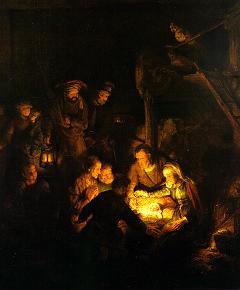
Adoration of the Shepherds
All rights reserved.
 John Seleden’s
John Seleden’s